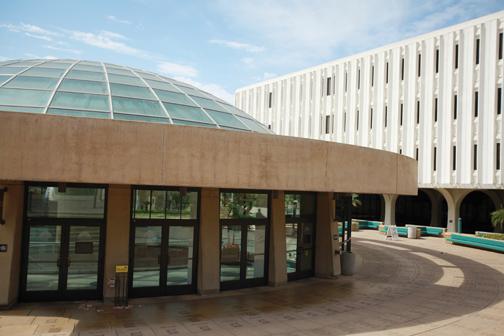
When the pandemic hit, the long 16-month quarantine took this away for many students who used the rich resources to succeed academically.
In accordance with campus policy, the library is requiring students to confirm their clearance to be on campus, via the HealtheConnect system. Once a student scans the QR code, a green COVID-19 medallion appears to notify security that the student is allowed in.
For SDSU Library security coordinator William Staninger, he’s doing everything in his power to
ensure that the library is safe.
“The idea is to keep staff safe, a lot of them are uncomfortable coming back to work around this many students,” Staninger said. “We have staff that are older and staff that are health compromised.”
The library, usually open for public access, put a hold on this call to ensure everyone who enters the library is vaccinated or has tested negative. This means it’s only open for SDSU students, faculty and staff.
Fifth year civil engineering major Anthony Bramante uses the library’s resources, he enters and exits the building daily and expresses his thoughts about the system in place.
“The medallion thing, once you get it taken care of, it’s not too difficult. It’s just hoop jumping, something you gotta get out of the way,” he said.
The library has also cracked down on showing screenshots, students would override the system with old screenshots of their medallion. Staninger says that he’s seen students share screenshots in front of him.
Bramante sees the thought of students doing this as dishonest and in opposition to the safety the library is supposed to provide.
“The system is done for a reason, it’s like paying taxes or driving the speed limit, you gotta do it and you can take whatever freedoms but you gotta follow the baseline.”
Similar to SDSU’s regulations, University of California San Diego has steps in place to protect students. Its library is open for public use but like SDSU, students are required to be vaccinated and masks are required indoors.
Benny Simon, a UCSD student, compared the two school’s COVID-19 policies.
Simon shared that like SDSU at UCSD, students must show they are cleared to enter certain buildings on campus. He said that instead of showing a badge like us, students at UCSD answer COVID-19 related symptom questions.
“I feel it’s unnecessary at UCSD, because it’s just measuring symptoms,” Simon said. “I think SDSU has a better policy.”
Even with the enforcements in place, both schools have some students who do not want to comply.
Others, like Bramante respect the rules but state his reason why he chooses not to wear a mask indoors.
“I do not wear a mask because I’m vaccinated and negative,” Bramante said. “I do my medalion to prove that I have a reason I’m not wearing a mask because I have nothing to spread.”
Staninger said if the university is already requiring students to be vaccinated or tested to even be on campus, stopping students at the door and checking is best for everyone’s safety.
Security can only mitigate the best they can, nothing is ever perfect.
The university had taken precautions to enforce COVID-19 policies including hiring the ELITE security force. Staninger said he was unsure of how long the university could sustain the enforcement.
Staninger asks students to understand that although we are back on campus, COVID-19 is still real and we are still living in a global pandemic. He understands the transition can be tough from being at home everyday to returning to student life.
“What I think we’re doing is necessary,” Staninger said. “At the end of the month we are going to reevaluate the situation.”
The evaluation will depend on the COVID-19 case counts on campus.






